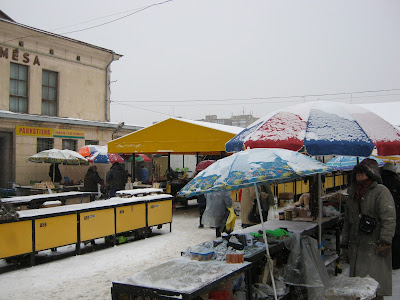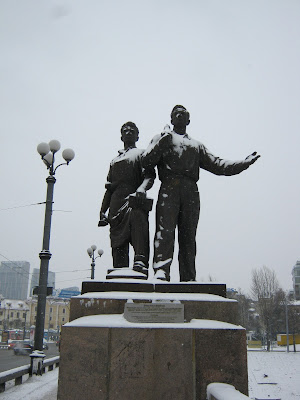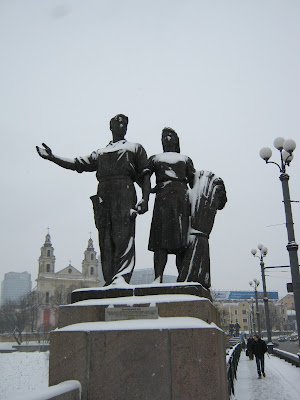Drinking our morning coffee on our last Tuesday in Vilnius we saw blue sky and sunshine out our skylight - let's get outside quick and enjoy it!
We felt like this guy - glad to be out, glad to be alive!
We headed east toward the old Subacious gate - past our friends' apartment building with its impressive wrought iron -
and the view from the eastern overlook was like seeing the city for the first time - in sunshine at last!
We descended the 100 or so steps - blessedly ice-free - and walked along the small Vilna River -
to the large white Russian Orthodox Church on its banks - the Church of the Holy Mother of God. The church has an unusual look, with a dome something like the church roofs you see in Armenia and Georgia.
We understand that in the early 1800s Vilnius University used it for a library, classrooms, and even dissection rooms for anatomy classes. Part of it was also used as a soldiers barracks before efforts began in the 1860s to restore it as a church.
The churches of Vilnius have endured some rough treatment. (Our Lutheran church being used as a warehouse and basketball court, as an example.) Then again, most of Vilnius' synagogues have completely disappeared.
We had not been inside this church before, so we went in and were greeted by a woman who demonstrated how to wipe our feet on the floor mat before walking on her freshly-clean floor. We followed her instructions.
It's a very large church, with the tallest iconostasis we've seen in Vilnius. We noticed that in a side chapel there was a coffin and flowers and a photo, and soon some people started arriving for a service - so we took our leave.
A few days ago we walked upriver to the St. Peter and Paul Church, a very special place - not so much for its exterior,
but for its brilliant white interior -
every inch of the inside is covered with white stucco saints and legends and frozen flowers and lace -a place where you could gaze and meditate for days.
I've never seen the Beatitudes on a church wall before. I'm guessing that on the left it says "blessed are those who mourn" and on the right "blessed are the poor." (But I didn't pack my Latin dictionary, so I'm not sure.)
On the left is St. Florian using a pitcher of water to douse a burning church. We often saw Florian's picture or statue on Austrian firehouses - the firefighters' patron saint. (Maybe I've even seen his picture on the firehouse in Kohler, Wisconsin - am I imagining things?)
And sailing through the middle of the nave is this Viking ship of brass and crystal.
When Liz was out walking some days ago she found an exhibit at a school and snapped some photos -
All made of papier-mache. We think the theme was something like (freely translating): Healthy Ways - Healthy Body, Healthy Soul.
Something a Family and Consumer Science teacher would be interested in.
Nevertheless we ended our sunny morning walk at
our favorite Italian bakery - a plain brioche for Liz and a barge-sized chocolate brioche for me.
Along with some scrambled eggs at home, it was a scrumptious ending to our sunny walk. I don't know what it did for my "kune" but my "siele" was very happy.




















































